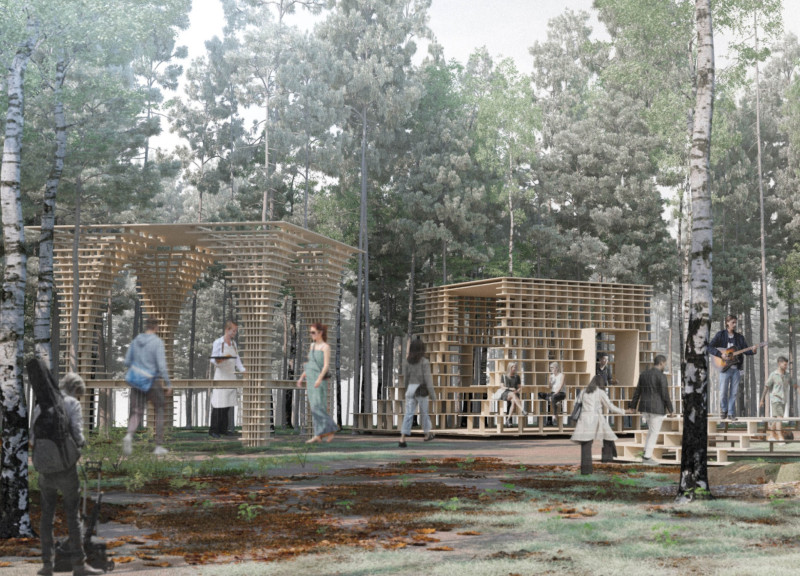5 key facts about this project
At its core, the project serves multiple functions, ranging from performance space to areas designated for social gatherings and educational workshops. The design reflects a deep understanding of these diverse needs, recognizing that architecture plays a crucial role in shaping user experiences. By blending sculptural forms with practical usability, the installation creates an inviting atmosphere conducive to artistic expression and community engagement.
One of the most notable aspects of “Land That Sings” is its use of locally sourced materials, with treated timber forming the backbone of the structure. This choice of material not only enhances the aesthetics of the design but also integrates the installation seamlessly into its forested surroundings. Plywood surfaces contribute to both the flooring and the internal partitioning of spaces, allowing for an efficient yet warm ambiance. Additionally, the integration of metal connectors serves to ensure structural integrity while maintaining a lightweight construct that does not overwhelm the landscape.
The architectural design embraces form and functionality through unique visual elements. The structure features arching forms that connect various spaces, creating a rhythm that resonates with the music shared within. Elevated balconies offer potential listening platforms where audiences can engage with performances from various vantage points, reinforcing the interactive experience that the project intends to cultivate. Seating arrangements throughout the installation promote social interaction, with seating configurations that invite conversation and connection among attendees.
The performance area stands as a central focus of the installation, designed to accommodate chamber music with an emphasis on acoustic quality. This space is carefully situated to utilize natural sound dynamics, ensuring that performances can be enjoyed in an immersive environment. The thoughtful arrangement allows musicians and audiences to share the space intimately, enriching the overall experience.
In addition to its primary function as a performance venue, the project features food stalls and communal dining areas that further facilitate social engagement. These areas are designed for ease of access, allowing visitors to transition smoothly from listening to music to enjoying meals and casual conversations. The thoughtful design of these space underscores the understanding of community interaction, making the installation a versatile venue.
Sustainability is a key consideration in the project’s development, evident through the commitment to local sourcing and the use of sustainable materials. By minimizing transportation costs and environmental impact through the selection of nearby resources, the design not only supports ecological considerations but also reflects a commitment to the community from which it draws its materials.
“Land That Sings” stands out for its unique approach to combining architecture with natural elements, creating spaces that invite participation and appreciation of the arts. The integration of nature into the design enhances not only the aesthetic appeal but also the functional aspects, allowing the installation to feel both immersive and supportive of communal gatherings.
For those interested in architecture, design, and communal engagement, exploring the detailed architectural plans and sections of “Land That Sings” will provide deeper insights into the project’s thoughtful approach and innovative solutions. This opportunity to delve into the architectural designs and ideas reinforces the importance of creating spaces that resonate with the community while nurturing artistic expression and interaction.


























